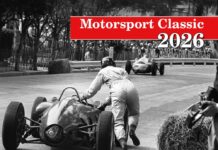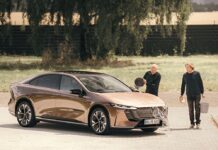75 years of Porsche sports cars: a pictorial journey through eight decades – with eight witnesses for whom tradition always also meant a new start.
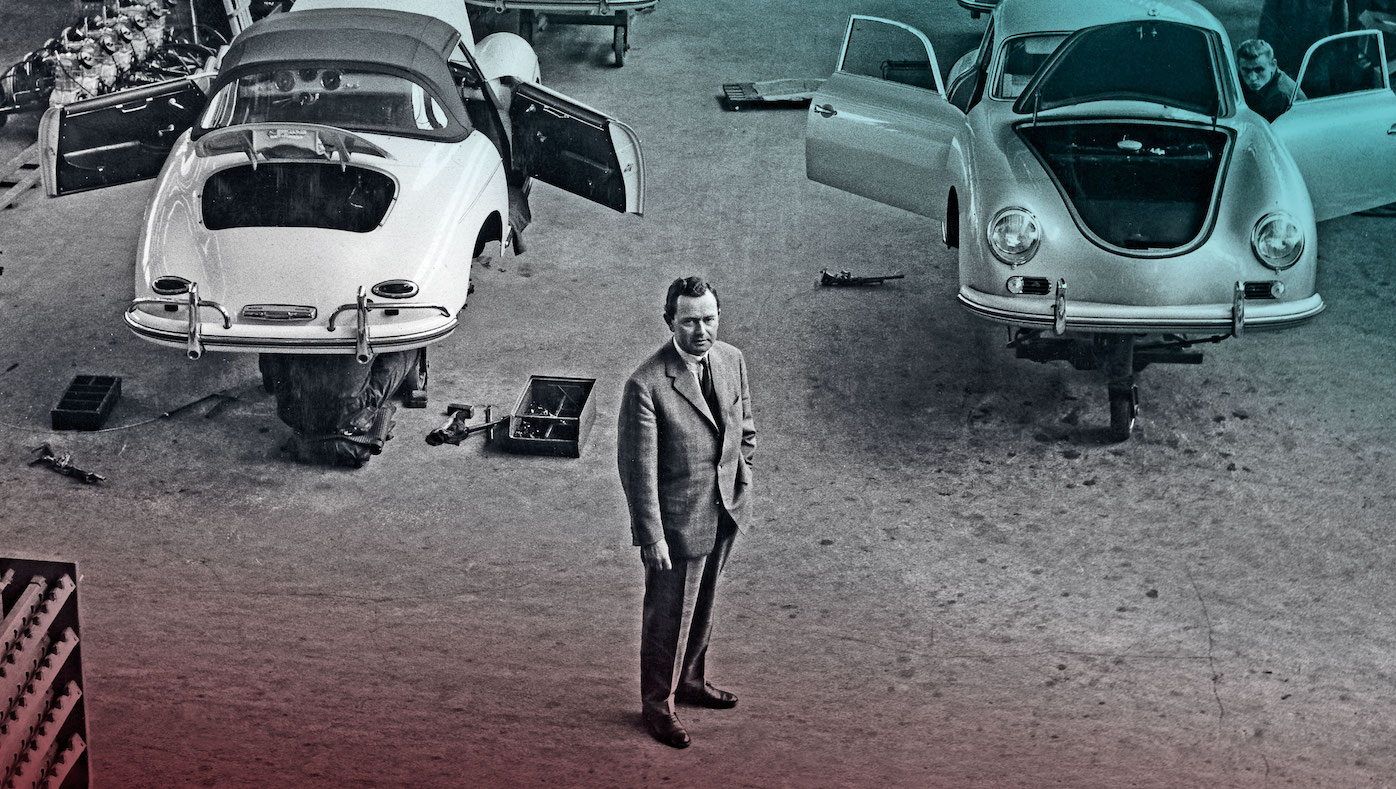
The first Porsche was awarded its general operating permit on June 8, 1948. Chassis number: 356-001. Model name: Porsche 356 “No. 1” Roadster. The founder of the sports car brand, Ferry Porsche, once summed up how this came about very succinctly: “In the beginning, I looked around and could not find quite the car I dreamed of. So I decided to build it myself.” A vision, a decision – a sports car.

The history of the Porsche brand is one of the greatest success stories in the automotive world. Among other things, because millions of people have dreamed – and still dream – of driving a very special car. And some think in even greater dimensions – they want to develop, design, lead the way. They are forward thinkers, trendsetters, pioneers. Starting with Ferry Porsche, they have shaped the company’s history as part of the Porsche family, be it at the drawing board, with their clay models, or behind a desk. Or alternatively behind the steering wheel – as it is, above all, the customers, the global community, who make the brand what it is: a dream come true. Christophorus looks back on eight moments that stand for how the brand has boomed through the ages – and on eight people who were there to witness this.
1948 | Karl Rabe
The birth of the first Porsche: “We drove back to Gmünd, arriving at 9 p.m. and covering a distance of 256 kilometers.” It is almost in passing that Karl Rabe records a historic moment in his diary on May 27, 1948 – the final test‑drive in the brand’s first dream car, the Porsche 356 “No. 1” Roadster. Alongside Ferry Porsche, the engineer was instrumental in developing the first sports car, produced in Gmünd in Austria, together with design engineer Erwin Komenda. This is now considered the origins of the brand. By this time, Rabe had had strong ties with the company for a long time, having met company founder Ferdinand Porsche at the vehicle manufacturer Austro-Daimler in Wiener Neustadt in 1913. He began to work at the Porsche engineering office in Stuttgart in 1930, where he helped develop models like the Porsche Type 60, which later became the Volkswagen. He made his mark on the 356, 550, and 911 models, and remained loyal to the Porsche brand through to retirement.
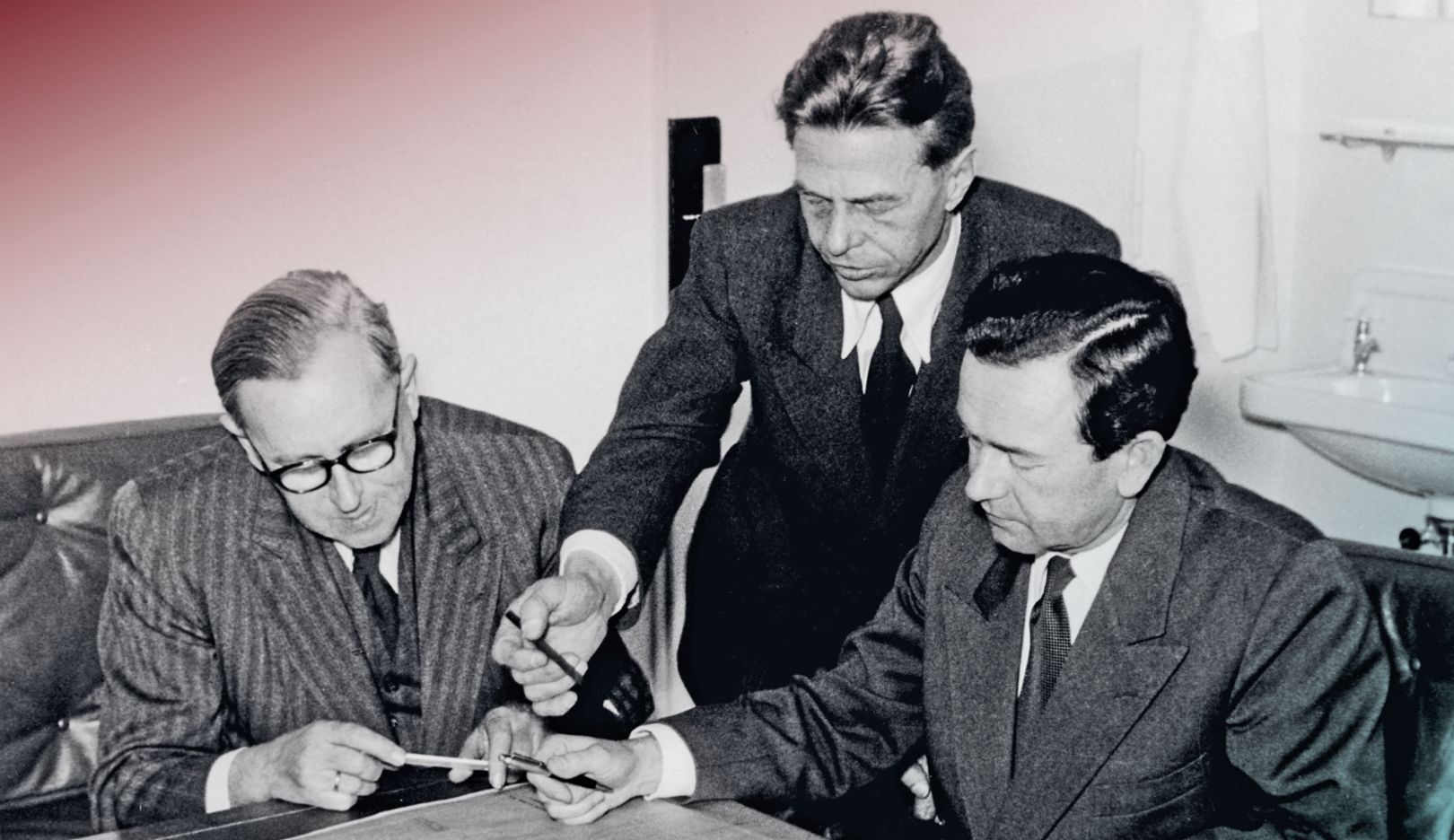
Historic trio:
Karl Rabe (left) with Porsche design engineer Erwin Komenda (middle) and Ferry Porsche, who Rabe served as a personal consultant after his retirement in 1965.
1953 | Gilberte Thirion
Dynamism as a mark of quality: Porsche initially had to earn a reputation for being a motorsport brand. Its premiere in the 24 Hours of Le Mans in 1951 was followed a year later by further milestones like its first attempt at the Carrera Panamericana rally in Mexico. Gilberte Thirion of Belgium was another individual who paved the way for the brand’s rise. The trained secretary was the first woman to enter the international motorsport stage in 1952. She was a pioneer of emancipation, a role model for many young women, and she gave Porsche Motorsport new drive.
“I read it all; I hear it all. And I really have the impression they’re talking about someone else.”
She also stood for people’s fascination with the Porsche 356 – irrespective of gender. In January, Thirion attended the Brussels Motor Show with her father Max. The 24-year-old was instantly taken by a sports car – a Gmünd Porsche with a lightweight aluminum body, the 356 SL. Shortly after, her father bought the car and gave it to Gilberte. And as early as in February, she took part in the Rallye Paris–Saint Raphaël Féminin, finishing in second place. There then followed an extraordinary five‑year racing career. After numerous overall wins including in the 12 Hours of Huy in 1954, the Stella Alpina in 1955, and the first Tour de Corse rally in 1956 as well as many class successes, she was the 1956 winner of the Belgian sports award, the Trophée National du Mérite Sportif. The race car driver was surrounded by considerable buzz, but she remained cool and controlled, exactly as she was when behind the wheel of her Porsche: “I read it all; I hear it all. And I really have the impression they’re talking about someone else.”
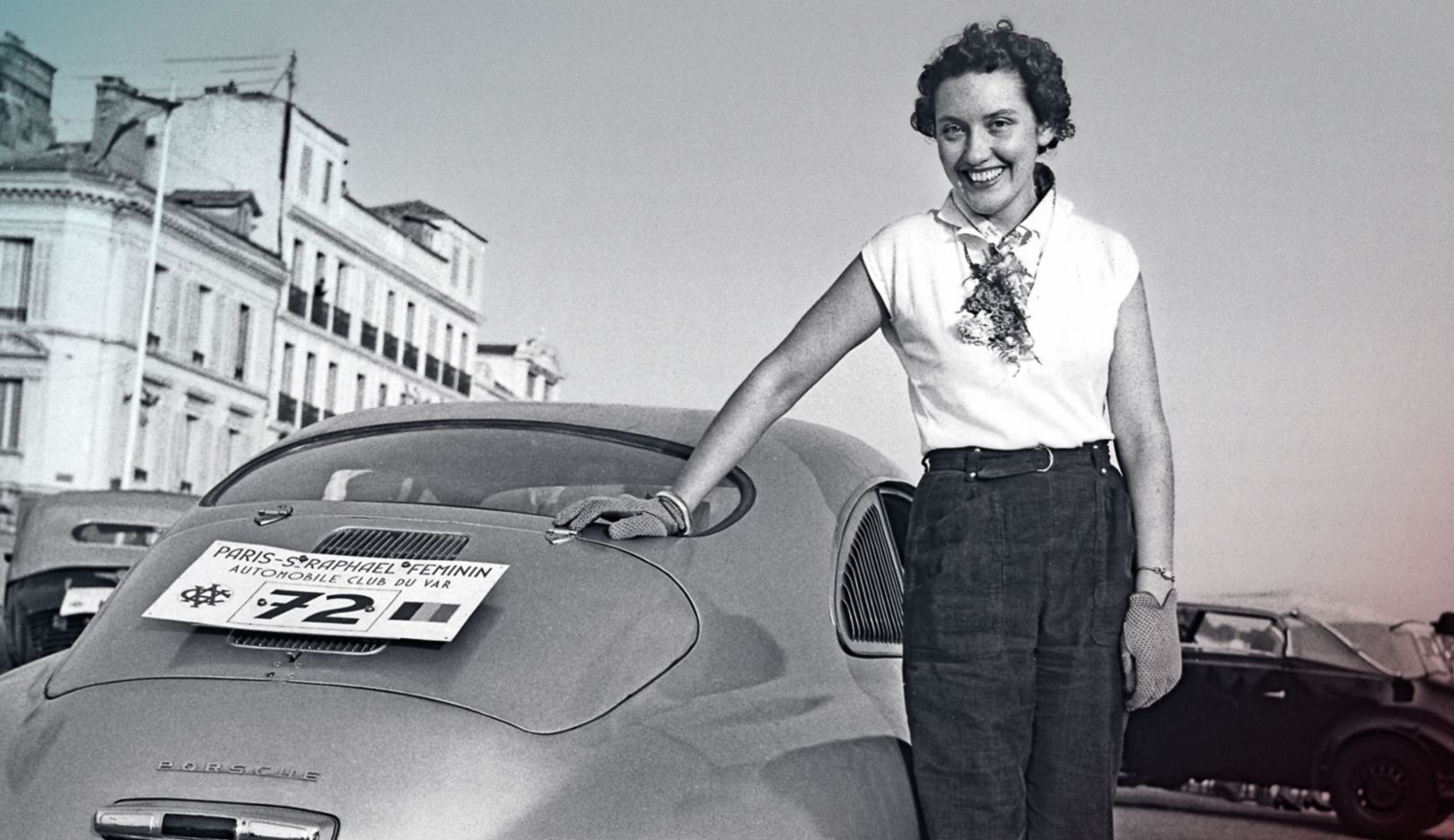
Motorsport pioneer:
Gilberte Thirion competes in the Rallye Paris–Saint Raphaël Féminin in the Porsche 356 SL in 1952.
Photo by Edward Quinn, © edwardquinn.com
Porsche on its way to being a global brand: Porsche has enjoyed the image of a sports car manufacturer par excellence on the other side of the Atlantic for a long time thanks to automobile importer Max Hoffman, who helped give the 356 its breakthrough in the USA in the 1950s. But in the 1960s, a new model made in Zuffenhausen needed promoting – the 911. Porsche was helped in this by someone who knows a thing or two about dreams, namely the astronaut Russell Schweickart. Schweickart, who is now 87, orbited Earth 151 times in March 1969 as pilot of the lunar module during the Apollo 9 mission.
“When you go around the Earth in an hour and a half, you begin to recognize that your identity is with that whole thing! And that makes a change.”
Back on Earth, the aerospace engineer fulfilled another great dream – that of owning a Porsche 911. He and his wife Claire collected the dark-blue Targa model from the factory in Zuffenhausen. This marked another milestone in the brand’s increasing internationalization – someone like Schweickart, a national hero with a dream job, traveling to Europe for their new sports car attracted a lot of attention. In the USA, the dream of flying to the Moon was joined by another one – the dream of driving a 911. By the early 1970s, the United States were already the biggest Porsche market in the world.
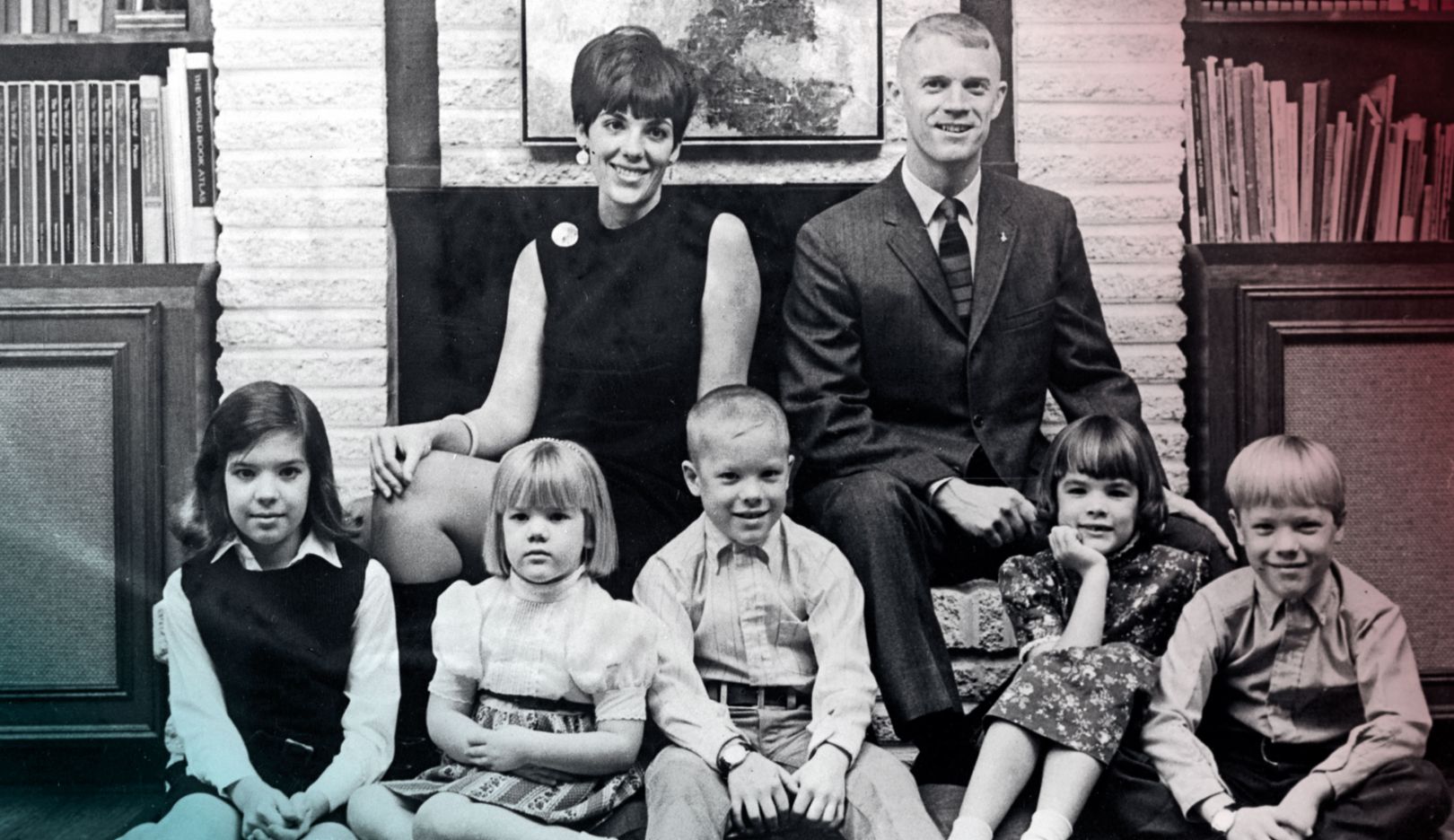
Astronaut and family man:
Russell Schweickart with his wife Claire and children Vicki, Diane, Rusty, Elin, and Randy (from left).
Photo by © Ullstein Bild – Topfoto
The courage to think differently: A wind of change was blowing at the company in the early 1970s. The Porsche and Piëch families were withdrawing from business operations and the 911 was due to be phased out. The new man at the top was Ernst Fuhrmann. And he promoted a model with a front engine. This was no easy task for Anatole Lapine, the brand’s chief designer from 1969 to 1988.
But the Latvian was a progressive dreamer – the 928 designed by him was the first Gran Turismo from Porsche with a front engine and was the result of a turnaround that set in at the beginning of the decade. Following its premiere at the Geneva International Motor Show in 1977, exactly 61,056 of this model were built up to 1995. In addition to the 928, other models produced under Lapine’s management included the G series, the 964 generation 911, the transaxle 924, the 944, and the 959 super sports car – all of which remain unconventional and thrilling to this day.
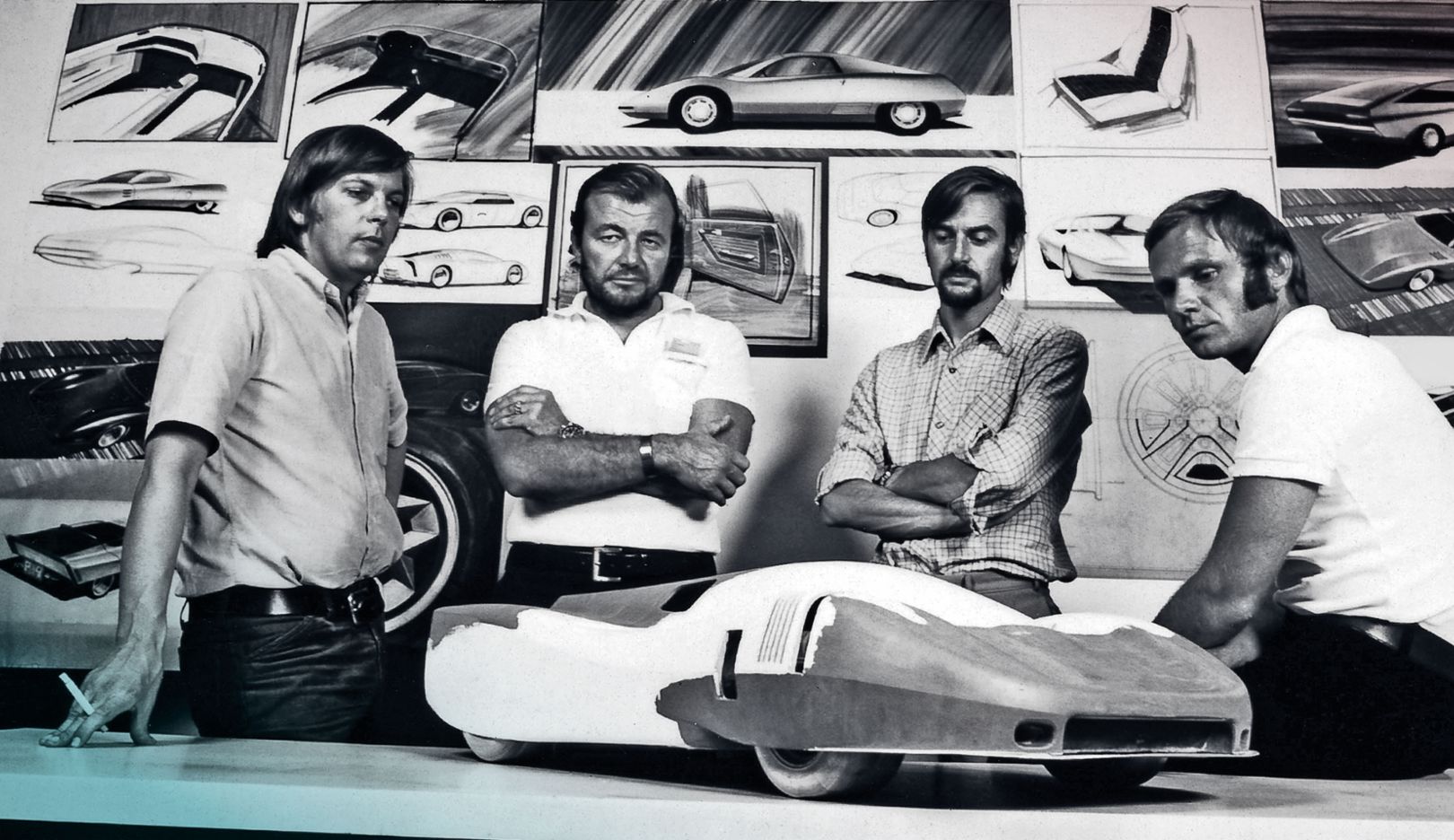
Brand shapers:
The Porsche designers Richard Soderberg, Anatole Lapine, Hans Braun, and Wolfgang Möbius (from left).
The 911 is saved: A quick course correction is sometimes the only right choice. In January 1981, Peter Werner Schutz hadn’t even been Chairman of the Executive Board of Porsche for three weeks when he reversed a long-standing decision – the 911 model would no longer be discontinued and replaced by the 928 as planned.
“The legend must be preserved.”
Instead, the 911 would continue to be built. What’s more, the German-American expanded the range of 911 models, for example by adding a cabriolet. Under his direction, Porsche increased its sales figures threefold, dazzled in Le Mans and in Formula 1, and boosted its profitability five years in a row – a dream for the Chairman of the Executive Board and for the company. He left the company at the end of 1987 when the business climate became rougher, in particular in the USA. By then, he had taken his most important decision almost six years previously. But even today, it seems entirely logical. Porsche without the 911? Inconceivable.
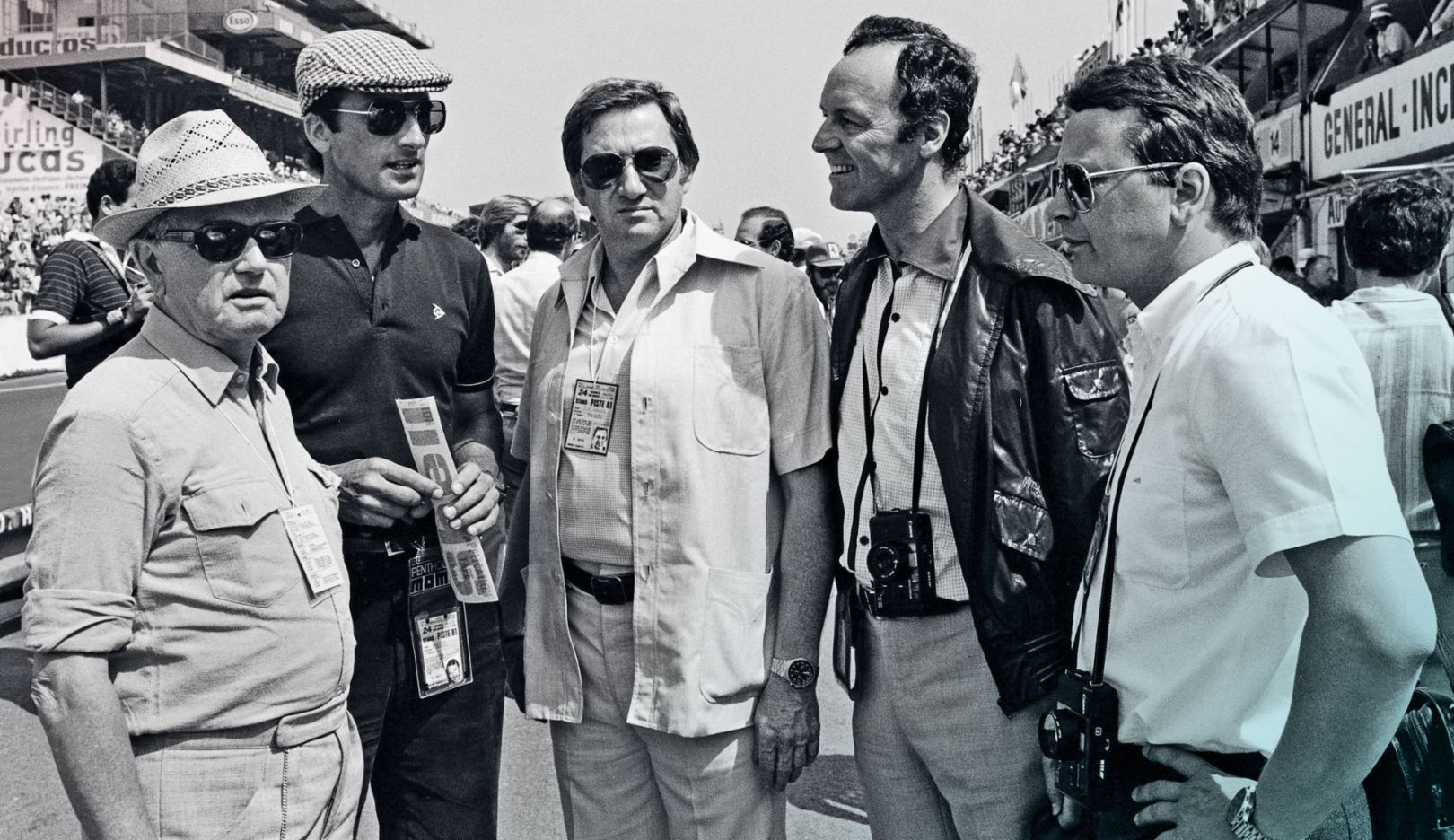
Le Mans, 1981:
Ferry Porsche, Manfred Jantke, Peter W. Schutz, Norbert Wagner, Dr. Wolfgang Porsche (from left).
1993 | Grant Larson
A new roadster: When Porsche unveiled a two-seater study, the Boxster, at the Detroit Auto Show in 1993, nobody knew how successful it would go on to be. But soon after, Porsche made a decision – a vehicle which was met with such rapturous praise by the press and the public had to be built. And would be built virtually unaltered. It was an extremely rare decision.
“The courage to dream.”
And precisely the right decision as Porsche has sold 350,000 of the Boxster to date. The one of a kind ingeniously combines the traditional and the modern – elements taken from the 550 Spyder and the 718 RS 60 are paired with a mid-engine concept and a sleek body. For team members like exterior designer Grant Larson, it was a dream job order in the early 1990s – design a show car, you have free rein. The American and his team seized the opportunity – and will be a part of Porsche history forever.
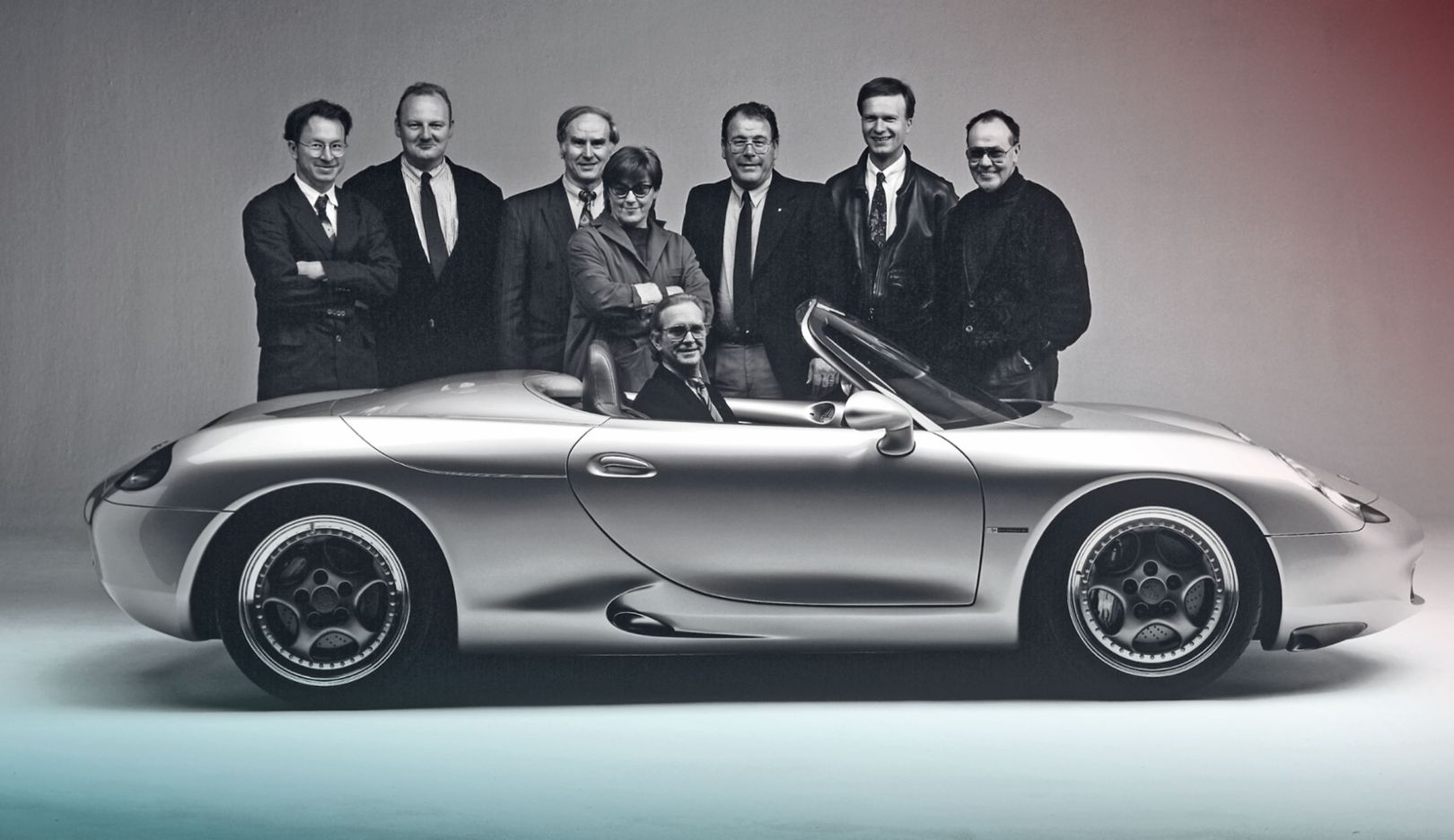
The study and the team:
Grant Larson (exterior), Jörg Kirschbaum (model designer), Otto Geffert (design engineer), Dorothea Müller-Goodwin (color and trim), Klaus Ziegler (model designer), Stefan Stark (interior), Peter Müller (head modeler) (from left). In the car, Head of Design Harm Lagaay.
Exploring unfamiliar terrain: The year 2002 represents a very special moment in the history of Porsche – the Cayenne featuring off-road capability became the first four-door model to be rolled out. Following its sales launch, the SUV became the dream Porsche for many customers around the world and was already the brand’s top-selling model just one year later. Among other things, thanks to Walter Röhrl.
“They’re off-road vehicles that can be driven like sports cars – a real sensation.”
In the course of his career, Röhrl, who is now 76, won world championship races not only in rallying, but also in motorsport. Porsche signed him as a works driver in 1981 and appointed him brand ambassador and development driver in 1993. Röhrl influenced the setup and technology of Porsche sports cars for decades with his ability to explain their handling both precisely and simply. His expertise also helped develop the outstanding handling and off-road characteristics of the Cayenne. Porsche and Röhrl proved that sports cars really could go off-road.
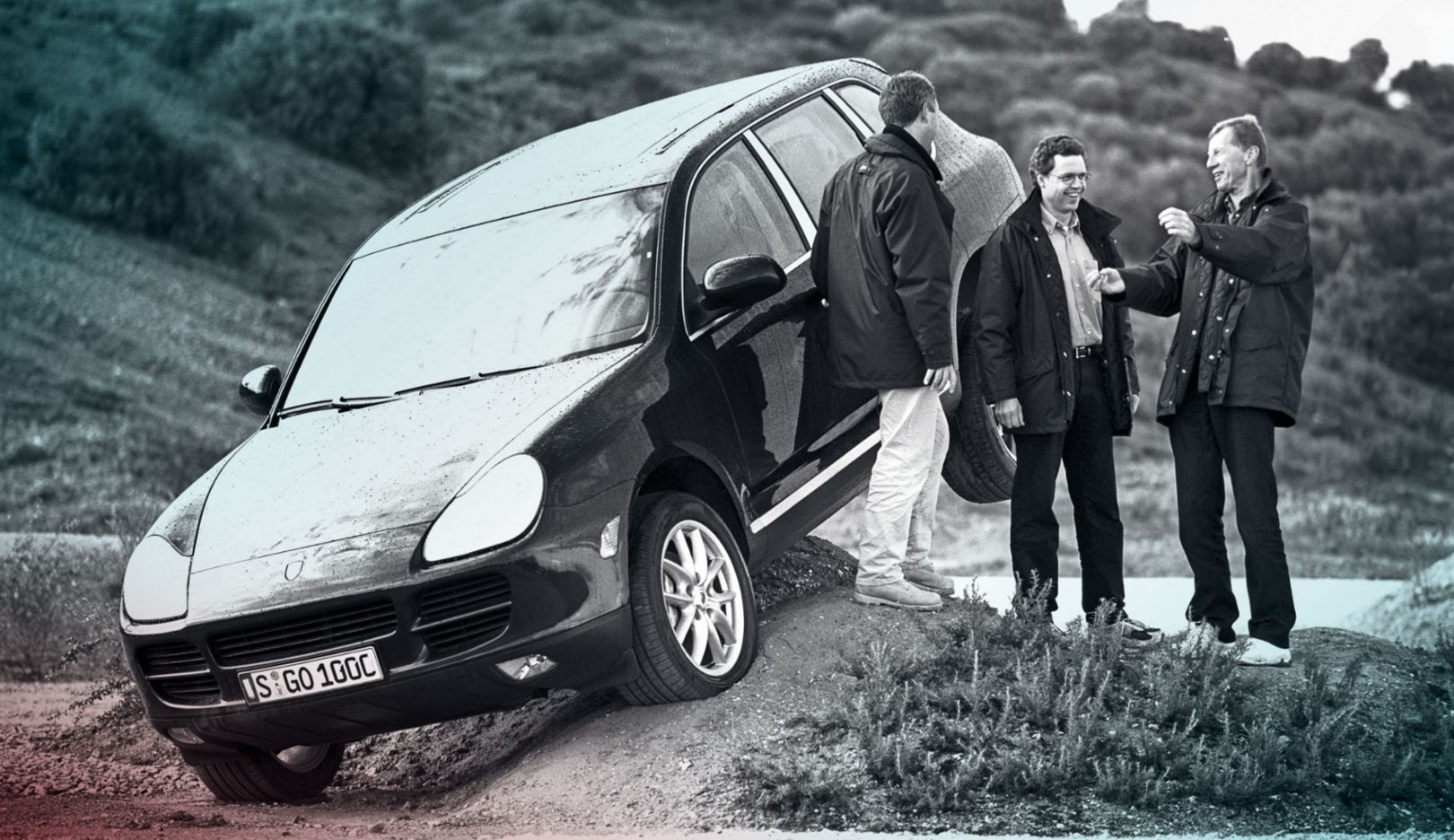
Ready to go off-road:
The expertise of Walter Röhrl (right) is needed. He is pictured here with the former Executive Vice President of Development Wolfgang Dürheimer (middle) in Jerez, Spain.
The beginning of an era: When, in 2018, the company announced production of the Taycan as its first all‑electric Porsche, it made another decision at the same time – the development of a new production line at the main assembly plant in Zuffenhausen.
“Heritage meets the future at our main assembly plant in Stuttgart-Zuffenhausen.”
It was a mammoth project which involved a factory being developed within a factory while the plant continued to roll out 718 and 911 sports cars every day. The factory ultimately offering 2,000 new jobs was opened in September 2019 – a huge team effort. Porsche production at the new factory is networked, flexible, and net CO₂ neutral. The 100,000th Taycan already rolled off the production line in November 2022.
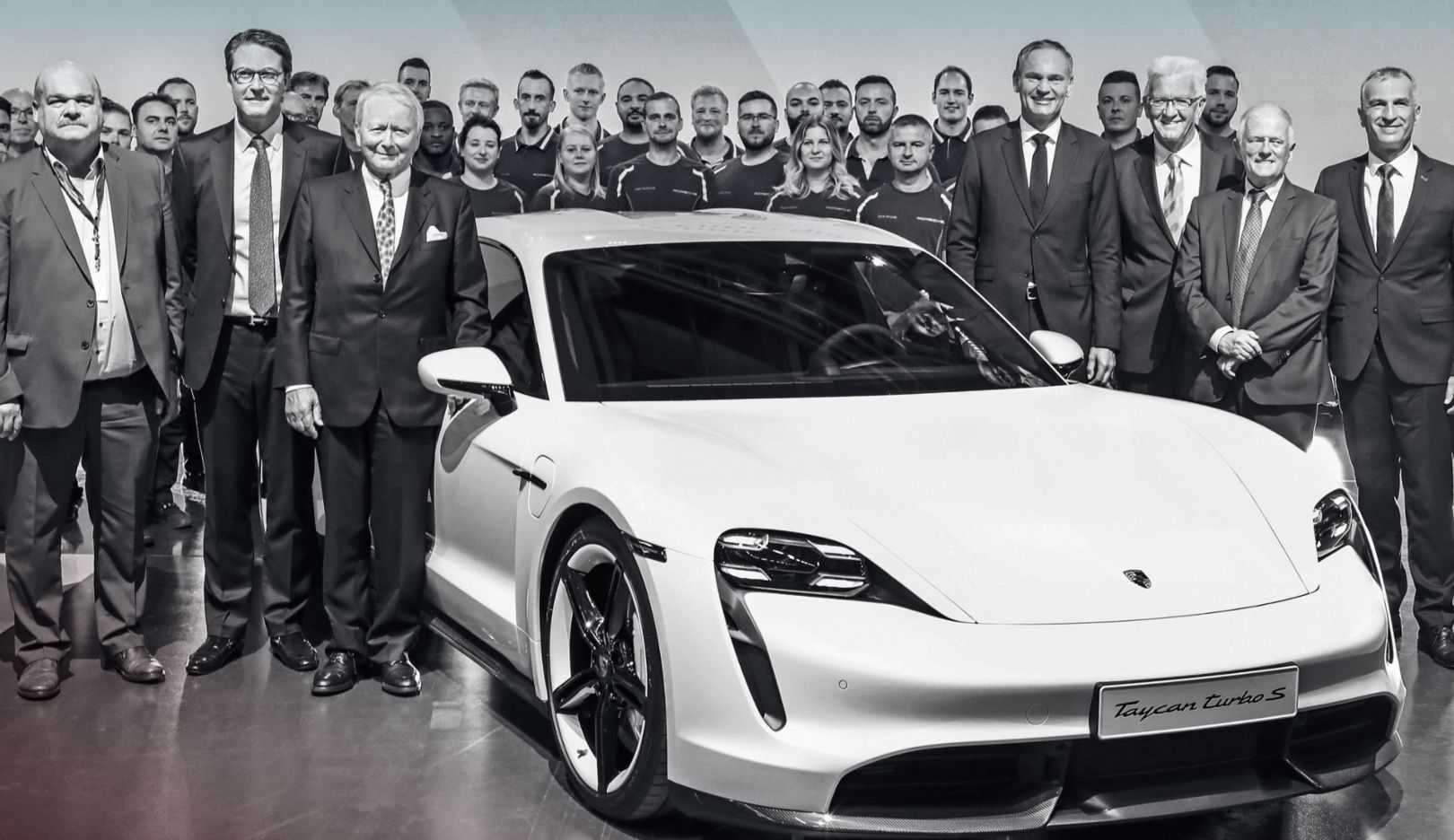
A grand beginning:
Factory opening with Porsche employees, and Werner Weresch, then Chairman of the General and Group Works Council; Andreas Scheuer, then Minister of Transport; Chairman of the Porsche Supervisory Board Dr. Wolfgang Porsche; Chairman of the Executive Board Oliver Blume; Minister-President of Baden-Württemberg Winfried Kretschmann; Fritz Kuhn, then Mayor of Stuttgart; and Member of the Porsche Executive Board responsible for Production Albrecht Reimold (front row, from left).
Report by Sven Freese for Porsche (first published on christophorus.porsche.com)
Photos by Edward Quinn and Ullstein Bild



